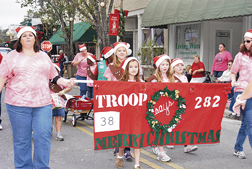Police say one man held High Springs woman at gunpoint
ALACHUA – Two Georgia men on the run from federal law enforcement officials were arrested in Alachua Sunday, Dec. 9.
One of the men was arrested following an alleged attempted kidnapping in which he held a woman at gunpoint outside of the Alachua Branch Library.
Shortly after noon on Sunday, police say 36-year-old Donald Mac Brown of Conyers, Georgia got out of his white Ford F-150 truck at the Alachua library and jumped into an open window of a parked Dodge Durango. In the driver’s seat of that SUV was a 44-year-old High Springs woman who began screaming after Brown brandished a .38-caliber handgun, which he held to her head.
While still partially hanging out of the vehicle, Brown reportedly ordered the woman to begin driving. He also tried to cover her mouth in an attempt to silence her, but the woman continued screaming and drawing attention to herself according to police records. After Brown continued demanding that the woman drive, she put the Dodge into gear and ultimately ran over a parking space curb. Police believe that spooked Brown who then fled the scene on foot into a nearby wooded area.
Upon hearing of the incident moments later, Alachua Police Department (APD) officers, along with the assistance of the Florida Highway Patrol and the Alachua County Sheriff’s Office, set up a perimeter around the area in search of Brown.
A short time later, Brown entered the Chevron gas station on U.S. 441 across from Alachua Elementary School and police say they saw him as he exited the convenience store and attempted once again to flee into the nearby wooded area. As a foot chase ensued, APD Sergeant Carl Newsome saw Brown pull out a handgun and drop it. Police were able to catch Brown.
Earlier that day, Alachua Police received a telephone call from 57-year-old David Crawford, also of Conyers, Georgia. Crawford told police that there was a warrant out for his arrest and he wanted to turn himself in to authorities. He asked police to meet him at a local restaurant and upon arriving, they verified his identity and that Crawford was indeed a wanted man. After placing him under arrest, they found a .357-caliber revolver concealed under his jacket.
Crawford and Brown are related by marriage according to police. The two men had been on the run since at least Dec. 5 when bulletins seeking them were issued in the Conyers, Georgia area.
Both men were wanted on pending child molestation charges.
Alachua Police Chief Joel DeCoursey said the men headed south on Interstate 75 and exited in Alachua to get fuel. They ultimately stayed in the area for three days. Crawford and Brown were camping out of their truck in a field along County Road 241 and believed to be less than a mile south of Irby Elementary School.
DeCoursey said that when police contacted the U.S. Marshalls Office to inform them of the arrests, officials there were surprised the men were taken alive. DeCoursey said at least one of the men apparently said he would not be taken alive and would not go back to jail.
APD Spokesman Jesse Sandusky said after impounding the Ford truck being driven by the men, police found multiple guns and knives inside.
They arrested Crawford on the outstanding warrant, but also charged him with carrying a concealed weapon. He’s being held in the Alachua County jail on a $35,000 bond.
Brown was charged with attempted kidnapping, armed burglary, resisting arrest without violence and tampering with evidence. He’s currently being held in Alachua County Jail on a $50,000 bond.
Upon extradition, both men are expected to face the pending molestation charges in Georgia.
# # #
Email editor@
alachuatoday.com



